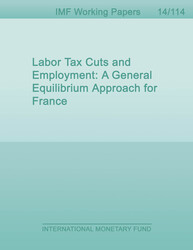
Labor Tax Cuts and Employment: A General Equilibrium Approach for France
The paper presents a simple supply side, general equilibrium model to estimate the macroeconomic effects of labor tax cuts. The model assumes that output is produced using capital, unskilled and skilled workers, and public servants. Wage formation for skilled workers features a Blanchflower-Oswald wage curve, while the labor supply for unskilled workers is very elastic around the minimum wage for small changes in employment. The model is calibrated for France and used to estimate the output and employment effects induced by two recent tax reforms: the Crédit d'Impôt pour la Compétitivité et l'Emploi (CICE) and the Pacte de Solidarité Responsabilité (RSP). We find that the tax cuts, if not offset by other fiscal measures, would contribute overall to creating around 200,000 jobs in the short run (600,000 jobs in the long run). Since the model abstracts from demand side effects, the results should be interpreted as providing estimates of the effect of tax measures on potential output and potential employment.
Publication date: July 2014
ISBN: 9781498328197
$18.00
Add to Cart by clicking price of the language and format you'd like to purchase
Available Languages and Formats
| English |
Prices in red indicate formats that are not yet available but are forthcoming.
Topics covered in this book
This title contains information about the following subjects.
Click on a subject if you would like to see other titles with the same subjects.
Economics- Macroeconomics , Economics / General , International - Economics , social security contributions , minimum wage , Responsibility Pact , pacte de responsabilité , crédit d’impôt pour la compétitivité et l’emploi , CICE
Summary
Copyright © 2010 - 2024
Powered by:
AIDC



